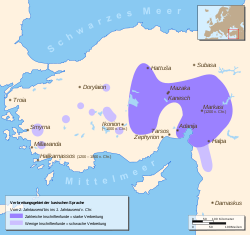
Çineköy inscription
Encyclopedia

Hieroglyphic Luwian
Hieroglyphic Luwian is a variant of the Luwian language, recorded in official and royal seals and a small number of monumental inscriptions. It is written in a hieroglyphic script known as Anatolian hieroglyphs...
-Phoenician bilingual
Bilingual inscription
In epigraphy, a bilingual is an inscription that is extant in two languages . Bilinguals are important for the decipherment of ancient writing systems.Important bilinguals include:...
, uncovered from Çineköy, Adana Province
Adana Province
Adana Province is a province of Turkey located in south-central Anatolia. With a population of 2,085,225, it is the fifth most populous province in Turkey. The administrative seat of the province is the city of Adana, home to 78% of the residents of the province...
, Turkey (ancient Cilicia
Cilicia
In antiquity, Cilicia was the south coastal region of Asia Minor, south of the central Anatolian plateau. It existed as a political entity from Hittite times into the Byzantine empire...
), dating to the 8th century BC
8th century BC
The 8th century BC started the first day of 800 BC and ended the last day of 701 BC.-Overview:The 8th century BC was a period of great changes in civilizations. In Egypt, the 23rd and 24th dynasties led to rule from Nubia in the 25th Dynasty...
. Originally published by Tekoglu and Lemaire (2000), it was more recently the subject of a 2006 paper published in the Journal of Near Eastern Studies
Journal of Near Eastern Studies
The Journal of Near Eastern Studies is an academic journal published by the University of Chicago Press, devoted to examination of the ancient and medieval civilisations of the Near East. Appearing in its pages are contributions from scholars of international reputation on archaeology, art,...
, in which the author, Robert Rollinger, lends support to the age-old debate of the name "Syria" being derived from "Assyria" (see Etymology of Syria).
The object on which the inscription is found is a monument belonging to Urikki, vassal
Vassal
A vassal or feudatory is a person who has entered into a mutual obligation to a lord or monarch in the context of the feudal system in medieval Europe. The obligations often included military support and mutual protection, in exchange for certain privileges, usually including the grant of land held...
king of Hiyawa
Quwê
Quwê – also spelled Que, Kue, Qeve, Coa, Kuê and Keveh – was a "Neo-Hittite" Assyrian vassal state or province at various times from the 9th century BCE to shortly after the death of Ashurbanipal around 627 BCE in the lowlands of eastern Cilicia, and the name of its capital city,...
(i.e. Cilicia
Cilicia
In antiquity, Cilicia was the south coastal region of Asia Minor, south of the central Anatolian plateau. It existed as a political entity from Hittite times into the Byzantine empire...
), dating to the eighth century BC. In this monumental inscription, Urikki made reference to the relationship between his kingdom and his Assyrian overlords. The Luwian inscription reads "Sura/i" whereas the Phoenician translation reads ’ŠR or "Ashur" which, according to Rollinger (2006), "settles the problem once and for all".
The Inscription
The examined section of the Luwian inscription reads:-
- §VI And then, the/an Assyrian king (su+ra/i-wa/i-ni-sa(URBS)) and the whole Assyrian "House" (su+ra/i-wa/i-za-ha(URBS)) were made a fa[ther and a mo]ther for me,
§VII and Hiyawa and Assyria (su+ra/i-wa/i-ia-sa-ha(URBS)) were made a single “House.”
- §VI And then, the/an Assyrian king (su+ra/i-wa/i-ni-sa(URBS)) and the whole Assyrian "House" (su+ra/i-wa/i-za-ha(URBS)) were made a fa[ther and a mo]ther for me,
The corresponding Phoenician inscription reads:
-
- And the king [of Aššur and (?)]
- the whole “House” of Aššur (’ŠR) were for me a father [and a]
- mother, and the DNNYM and the Assyrians (’ŠRYM)
- were a single “House.”

